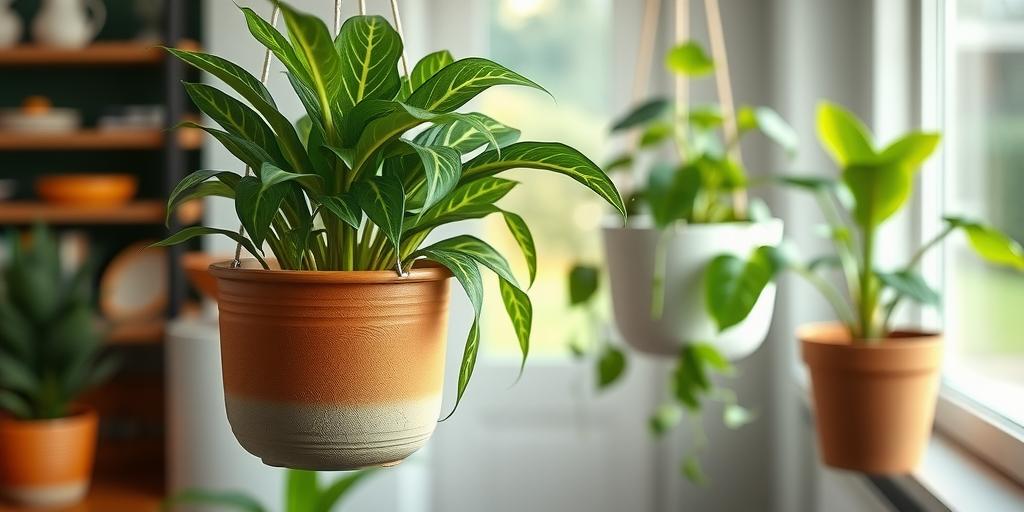
Pet-Safe Low Light Hanging Plants for Homes with Kids and Pets
Looking for pet-safe low light hanging plants that thrive indoors and are safe for kids and pets? Discover the best non-toxic, easy-care options to brighten up your home!
Introduction
Did you know that over 30% of houseplants are toxic to pets? If you’re a plant-loving pet parent or have curious kids at home, finding the right hanging plants can be tricky—but don’t worry! We’ve got you covered with the best pet-safe, low-light hanging plants that are beautiful, easy to maintain, and safe for your furry friends and little ones. Whether your home lacks bright sunlight or you just want worry-free greenery, these plants will bring life to your space without the stress. Let’s dive in!
Why Choose Pet-Safe Low Light Hanging Plants?
Hanging plants are a fantastic way to bring greenery into small spaces without sacrificing floor space. They add a touch of nature, improve air quality, and create a calming atmosphere—especially in apartments or homes with limited room. But if you have pets or small children, choosing the right plants becomes even more important.
Benefits of Hanging Plants in Small Spaces
Hanging plants are perfect for tight spaces because they utilize vertical space, leaving your counters, shelves, and floors free. They can brighten up dark corners, soften harsh lines in modern décor, and even help with noise absorption in open-concept living areas. Plus, trailing plants like spider plants and pothos (though not all pothos are pet-safe) create a lush, cascading effect that adds visual interest.
Risks of Toxic Plants for Pets and Children
Many common houseplants, like pothos, philodendrons, and snake plants, can be toxic to pets if ingested. Cats and dogs are naturally curious and may nibble on leaves, leading to vomiting, diarrhea, or worse. Kids, especially toddlers, might also pull on leaves or put them in their mouths. That’s why opting for pet-safe plants is a must—you get all the beauty without the worry.
How Low-Light Plants Thrive in Indoor Conditions
Not every home gets bright, direct sunlight, but that doesn’t mean you can’t have thriving plants. Low-light plants have adapted to grow under tree canopies in nature, making them perfect for dimmer indoor spaces. They require less frequent watering and can tolerate indirect light from north-facing windows or artificial lighting. This makes them ideal for busy plant parents or those new to indoor gardening.
Top Pet-Safe Low Light Hanging Plants
If you’re looking for beautiful, non-toxic plants that thrive in low light, here are some of the best options:
Spider Plant (Chlorophytum comosum) – Non-Toxic, Air-Purifying, and Easy to Grow
Spider plants are a classic choice for pet owners. Not only are they completely safe for cats and dogs, but they’re also incredibly resilient. They produce long, arching leaves and tiny “spiderettes” that dangle from the mother plant, making them perfect for hanging baskets. Plus, they’re known for their air-purifying qualities, removing toxins like formaldehyde from the air.
Boston Fern (Nephrolepis exaltata) – Lush Foliage, Safe for Pets, Loves Humidity
If you want a full, feathery look, Boston ferns are a great pick. They’re non-toxic and thrive in humid environments, making them ideal for bathrooms or kitchens. Just keep the soil consistently moist (but not soggy) and mist the leaves occasionally to prevent browning.
Peperomia (Peperomia spp.) – Compact, Colorful, and Pet-Friendly
Peperomias come in a variety of shapes and colors, from the ripple-textured leaves of the Peperomia caperata to the watermelon-patterned Peperomia argyreia. They’re small, slow-growing, and completely safe for pets. Their compact size makes them great for small hanging planters or macramé hangers.
Staghorn Fern (Platycerium spp.) – Unique Shape, Low Maintenance, Non-Toxic
Staghorn ferns are epiphytes, meaning they naturally grow on trees rather than in soil. Their unusual antler-like fronds make them a striking addition to any space. Mount them on a wooden board or hang them in a basket with sphagnum moss. They prefer bright, indirect light but can tolerate lower light conditions with proper care.
Parlor Palm (Chamaedorea elegans) – Elegant and Safe for Cats & Dogs
While not a trailing plant, parlor palms can still look stunning in hanging planters if pruned properly. They’re safe for pets and add a tropical touch to any room. They grow slowly and prefer indirect light, making them a low-maintenance choice.
How to Care for Pet-Safe Hanging Plants
Keeping your hanging plants healthy doesn’t have to be complicated. Here’s what you need to know:
Best Watering Practices for Low-Light Plants
Since low-light plants grow slower, they don’t need as much water as sun-loving varieties. Always check the soil before watering—stick your finger about an inch deep. If it’s dry, it’s time to water. Overwatering is a common mistake that leads to root rot, so err on the side of underwatering.
Ideal Placement for Indirect Sunlight
Most low-light plants prefer bright, indirect sunlight. A few feet away from a north or east-facing window is ideal. Avoid direct afternoon sun, which can scorch delicate leaves. If your space is very dark, consider supplementing with a grow light.
Safe Fertilizers and Soil Tips
Use a well-draining potting mix to prevent waterlogging. Organic fertilizers like worm castings or diluted fish emulsion are safe for pets and provide gentle nutrients. Avoid chemical-heavy fertilizers, which can be harmful if ingested by curious pets.
Pruning and Maintenance for Healthy Growth
Regularly trim yellow or dead leaves to encourage new growth. For trailing plants like spider plants, you can propagate the baby plantlets and expand your collection. Wiping leaves with a damp cloth removes dust and helps the plant breathe better.
Pet-Proofing Your Hanging Plants
Even with pet-safe plants, you’ll want to take extra precautions to keep both your greenery and your pets happy.
How to Keep Pets from Chewing on Plants
Some pets just can’t resist a dangling leaf. To deter chewing, try spraying plants with a pet-safe bitter spray (available at pet stores). You can also place citrus peels around the base—most cats dislike the smell.
Choosing Sturdy, Pet-Resistant Hanging Planters
Opt for heavy-duty planters that won’t easily tip if a curious pet tugs on them. Metal or ceramic hangers are more durable than lightweight plastic. Make sure hooks and brackets are securely fastened to avoid accidents.
Training Tips to Deter Pets from Digging or Playing with Plants
Positive reinforcement works best. Reward your pet when they ignore the plants and redirect them with toys if they get too interested. For persistent diggers, place decorative rocks or mesh over the soil to block access.
Styling Tips for Hanging Plants in Kid & Pet-Friendly Homes
Hanging plants can be both functional and stylish—here’s how to make them work in a busy household.
Creative Ways to Hang Plants Out of Reach
Mount hooks high on walls or ceilings where pets can’t reach. Use tension rods in windows for a floating garden effect. Corner shelves with hanging planters keep plants elevated while adding dimension to the room.
Pairing Plants with Pet-Safe Décor
Match your planters with your home’s aesthetic—macramé hangers for boho vibes, sleek metal for modern spaces. Avoid small decorative items that pets might knock over or swallow.
Best Rooms to Place Hanging Plants for Aesthetics and Safety
Bathrooms and kitchens are great for humidity-loving plants like ferns. Living rooms benefit from air-purifying varieties like spider plants. Bedrooms can use calming greenery like parlor palms—just keep them high enough to avoid midnight nibbling!
By choosing the right plants and taking a few precautions, you can enjoy a lush, green home without compromising your pets’ safety. Happy planting!
Conclusion
Transforming your home into a green oasis doesn’t have to be risky for your pets or kids! With these pet-safe, low-light hanging plants, you can enjoy lush, vibrant greenery without worry. Whether you opt for a Spider Plant, Boston Fern, or Peperomia, each of these plants brings beauty and peace of mind. Ready to get started? Pick your favorite and let nature thrive safely in your home!
